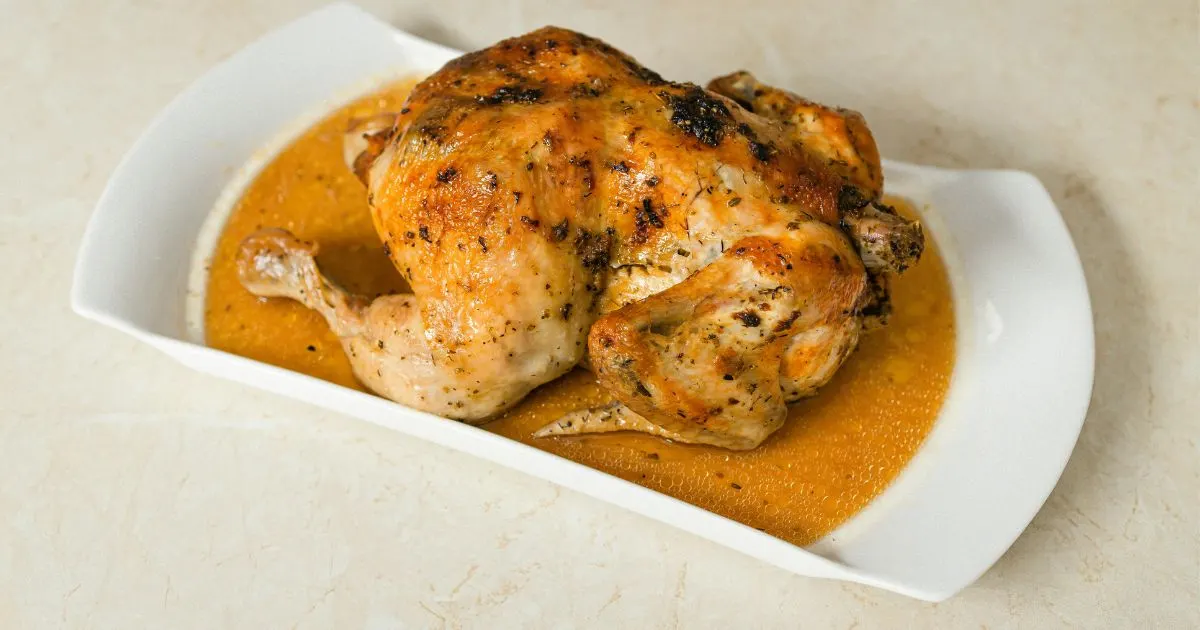🏆 Perfect Chicken Brine Recipe
A foolproof guide to making the best chicken brine for juicy, flavorful results
If you’ve ever wondered how restaurants manage to serve perfectly juicy chicken every time, the secret often lies in one simple kitchen technique: brining. This chicken brine recipe transforms even the most basic cut of chicken into a mouthwatering, tender, and flavor-packed dish that your family will crave again and again.
Brining isn’t just for Thanksgiving turkeys — it’s a game-changing method for everyday chicken breasts, thighs, and whole birds. Whether you’re grilling, roasting, or frying, this perfect chicken brine ensures that every bite stays moist and flavorful from the inside out.
In this complete guide, you’ll learn:
✅ What brining is and why it works
✅ How to make a simple, effective brine with pantry staples
✅ The exact step-by-step method to brine any chicken cut
✅ Pro tips, FAQs, and expert variations to level up your dish
✅ How to store, cook, and serve brined chicken for best results
🔍 Why This Recipe Works
- Scientifically backed: The salt solution changes the protein structure of the chicken, locking in moisture.
- Customizable flavor: Add herbs, spices, citrus, or even sweeteners for endless flavor options.
- Beginner-friendly: No special equipment required — just water, salt, sugar, and time.
📷 Image #1:
Flat lay of basic chicken brine ingredients on a wooden kitchen counter – kosher salt, sugar, peppercorns, bay leaves, garlic, and water in a glass measuring cup.

📷 Image #2:
A raw whole chicken being placed into a clear glass bowl filled with brine, surrounded by herbs and lemon slices.

📷 Image #3:
A side-by-side comparison: plain cooked chicken vs. brined cooked chicken sliced open to reveal juiciness and texture difference.
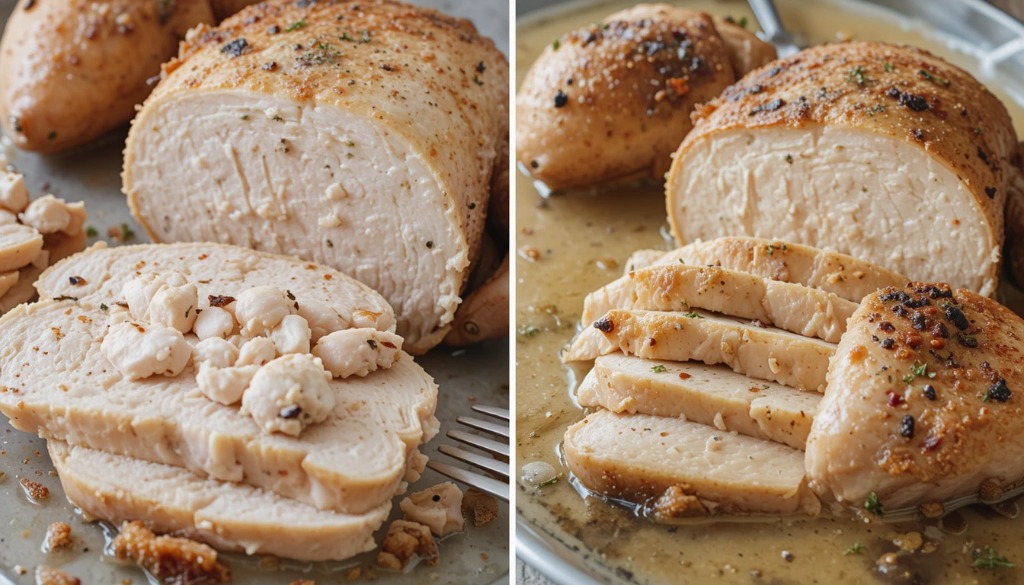
By the end of this post, you’ll have everything you need to master the art of chicken brining—whether you’re preparing a quick weeknight dinner or impressing guests at a holiday meal.
👉 Let’s dive in and start building the best chicken you’ve ever made!
.
🧂 🧂 H2: Ingredients for the Best Chicken Brine
The beauty of a great chicken brine recipe lies in its simplicity. Most of the ingredients are probably already in your pantry. A basic brine combines just a few essentials, but you can easily build extra flavor by adding herbs, spices, and aromatics. Below, we’ll break it down into the core ingredients, offer substitutions, and explore optional add-ins that elevate your brine from good to gourmet.
✅ Simple Pantry Staples
These core ingredients form the foundation of a reliable, effective chicken brine:
- Water – Acts as the base; use cold, filtered water if possible.
- Kosher Salt – Essential for drawing moisture into the chicken; avoid table salt unless measuring carefully.
- Sugar – Balances the saltiness and enhances browning when cooking. White or brown sugar works well.
💡 Basic Ratio for Chicken Brine:
For every 1 gallon (16 cups) of water:
- ¾ cup kosher salt
- ½ cup sugar

🧾 Ingredient Notes & Substitutions
- Salt: Always use kosher salt or sea salt for accuracy. If you’re using table salt, reduce the amount by 25% (it’s denser).
- Sugar: Brown sugar adds a deeper flavor; honey or maple syrup can be used for a natural twist.
- Water: If you want to infuse more flavor, replace some of the water with apple cider, vegetable broth, or tea.
Substitutions are fine as long as the salt-to-liquid ratio remains consistent to maintain proper brining chemistry.
🌿 Optional Add-Ins for Extra Flavor
Want to upgrade your brine to a flavor powerhouse? Try these popular add-ins:
- Garlic cloves (crushed)
- Peppercorns
- Bay leaves
- Fresh herbs: rosemary, thyme, parsley
- Citrus: lemon or orange slices and zest
- Spices: cinnamon sticks, chili flakes, cloves
These extras infuse the chicken with aroma and subtle flavor undertones, making it even more mouthwatering once cooked.

🍗 🥣 H2: How to Brine Chicken
Brining chicken is easy — and once you learn the method, you’ll never go back to bland or dry poultry again. Whether you’re preparing a whole bird for roasting or individual chicken pieces for the grill, this step-by-step guide will walk you through everything you need to know.
🔧 Step-by-Step Instructions
Follow these simple steps to make the perfect chicken brine:
- Mix the Brine
In a large pot or mixing bowl, dissolve the salt and sugar in warm water. Stir until fully dissolved. Let it cool to room temperature or chill it with ice cubes. - Add Flavorings (Optional)
Drop in your aromatics, herbs, spices, and citrus. Stir to combine and boost flavor. - Submerge the Chicken
Place the chicken (whole or pieces) into a container or sealable bag. Pour in the cooled brine until fully covered. - Refrigerate and Brine
Cover and refrigerate. Let it soak based on the brining time (see below). - Remove and Rinse
Take the chicken out of the brine, discard the liquid, and give it a quick rinse under cold water to remove excess salt. - Pat Dry and Cook
Pat the chicken dry with paper towels. Now it’s ready to roast, grill, bake, or fry!

🍗 Tips for Brining Whole Chicken vs. Pieces
- Whole Chicken:
Use a stockpot, large bowl, or brining bag. Ensure the chicken is fully submerged. You may need to weigh it down with a plate. - Chicken Breasts, Thighs, or Drumsticks:
Use a zip-top freezer bag or shallow dish. These cuts require less brine and less time.
🧊 Pro Tip: Always refrigerate during brining to prevent bacterial growth. Add a few ice cubes to cool the brine quickly if you’re in a rush.
⏱️ How Long to Brine Chicken
Timing is everything! Brine long enough to infuse flavor but not so long that it affects texture.
| Chicken Cut | Brining Time |
| Whole Chicken | 8–12 hours |
| Bone-in Pieces | 2–4 hours |
| Boneless Breasts | 30 minutes–1 hour |
| Chicken Wings | 1–2 hours |
⚠️ Over-brining can lead to mushy meat or excessive saltiness — stick to the guidelines above for the best results.
🍽️ How to Use Brined Chicken in Recipes
Once brined, your chicken is ready to shine in just about any recipe! Brining enhances moisture retention, making it perfect for:
- Grilling – Keeps breasts from drying out.
- Roasting – Achieve crispy skin and juicy meat.
- Frying – Adds extra flavor beneath the crunch.
- Slow Cooking – Prevents blandness in stews and soups.
💡 Pro Tip: For crispy skin, allow brined chicken to air-dry in the fridge for 1–2 hours before cooking.

💡 💡 H2: Why You Should Brine Chicken
Brining is the secret weapon of chefs and home cooks alike when it comes to juicy, flavorful chicken. Whether you’re preparing a whole bird or individual pieces, using a chicken brine recipe can elevate your dish from average to amazing. Let’s explore what brining is, how it works, and why it’s worth adding to your cooking routine.
🧪 What is Brining?
Brining is the process of soaking meat in a saltwater solution, often enhanced with sugar, spices, and aromatics. The salt in the brine breaks down muscle fibers in the chicken, allowing it to absorb more moisture and flavor before cooking.
There are two main types of brining:
- Wet Brine – Soaking the chicken in a salty liquid mixture (most common).
- Dry Brine – Rubbing salt directly on the chicken and letting it rest uncovered in the fridge.
For most home cooks, wet brining is the easiest and most forgiving method — perfect for roasts, grilled chicken, and fried dishes.

🧬 How Brining Works to Tenderize Meat
Salt plays a critical role in improving the texture and moisture of meat:
- Denatures Proteins: Salt unwinds muscle fibers, allowing them to trap more water.
- Increases Moisture Retention: Brined chicken retains liquid during cooking, resulting in juicier meat.
- Enhances Flavor: Salt and any added seasonings seep into the meat over time, subtly seasoning it throughout.
This process not only prevents dry, bland chicken, but also enhances the tenderness, making each bite more enjoyable.
✅ Benefits of Using a Chicken Brine Recipe
Brining isn’t just a trend — it’s a proven method with real culinary benefits:
- Juicier Meat: Especially helpful for lean cuts like chicken breasts.
- Enhanced Flavor: Even a basic salt brine improves taste dramatically.
- Crispier Skin: When dried properly after brining, skin roasts or fries to golden perfection.
- Better Texture: No more stringy or rubbery chicken.
- Customizable: You can infuse the brine with herbs, spices, garlic, citrus, and more.
Whether you’re hosting a dinner party or prepping a weeknight meal, brining is an easy step that delivers professional-quality results every time.
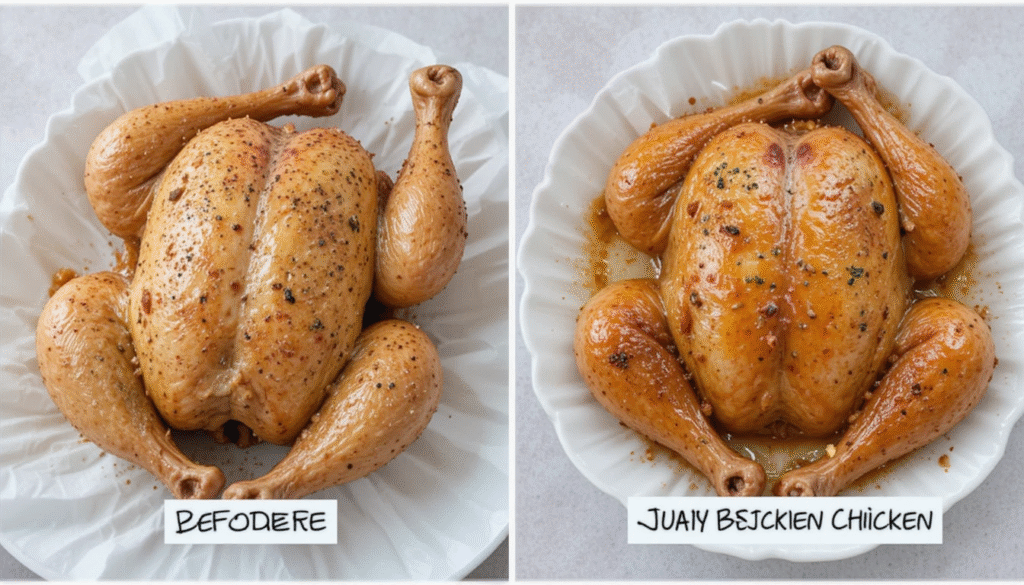
🧠 H2: Expert Tips for the Perfect Brine
Mastering the art of brining isn’t just about following a recipe — it’s also about knowing the smart techniques and avoiding common pitfalls. These expert tips will help you get the most out of your chicken brine recipe, whether you’re a beginner or seasoned home cook.
🥇 Tips for Success
To get consistently juicy, flavorful chicken every time, keep these brining best practices in mind:
- Use Kosher Salt: It dissolves easily and has larger grains, which are perfect for brining. Avoid table salt unless adjusted (it’s denser).
- Chill Your Brine: Never pour hot or warm brine over raw chicken. Always cool it first using ice or refrigeration.
- Keep It Covered and Cold: Brine in the fridge to avoid bacteria growth. Never brine at room temperature.
- Rinse and Dry After Brining: Gently rinse off excess salt, then pat the chicken dry. This helps prevent overly salty flavor and promotes crispy skin.
- Adjust Time for Cut Size: Brining too long can lead to mushy chicken. Follow timing guidelines for whole birds vs. pieces.
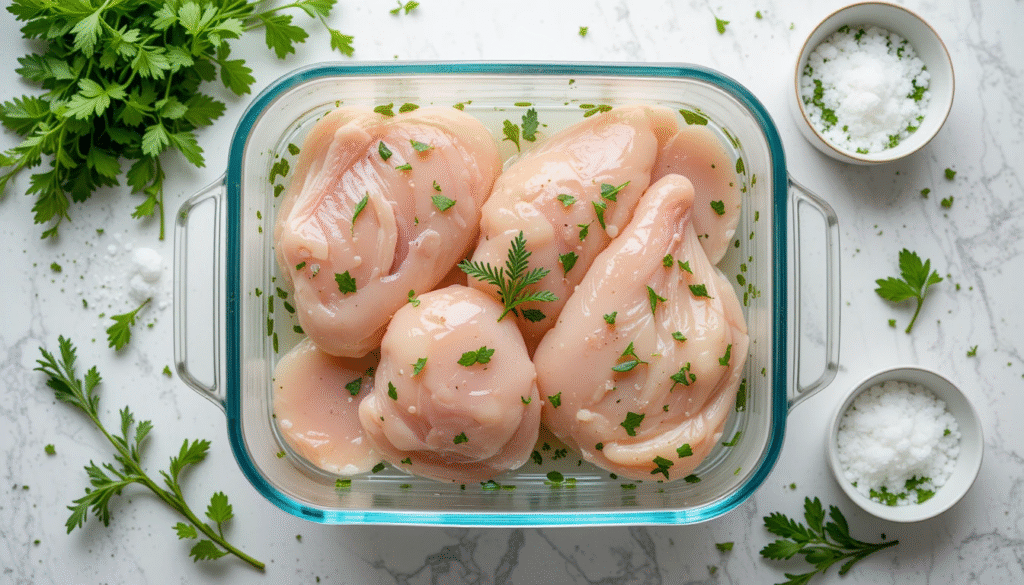
⚠️ Common Mistakes to Avoid
Avoid these mistakes to ensure your chicken turns out just right:
- ❌ Over-brining: Brining too long can make the meat overly salty or spongy in texture.
- ❌ Too Much Salt: Always measure your salt — too much can’t be undone.
- ❌ Using Table Salt Without Adjusting: It’s more concentrated than kosher salt. Use less if substituting.
- ❌ Skipping the Drying Step: Wet skin prevents browning. Always dry the chicken before cooking.
- ❌ Not Cooling the Brine: Warm brine can partially cook the chicken and create food safety issues.
💡 Pro Tip: Want ultra-crispy skin? Let your brined chicken rest in the fridge uncovered for 1–2 hours before cooking.
💰 Storage, Prep Ahead & Budget-Friendly Tips
Maximize efficiency and flavor while saving time and money:
- Make Brine Ahead: You can mix and refrigerate your brine up to 3 days in advance.
- Freeze Chicken in Brine: Place chicken and brine in a freezer-safe bag and freeze for future use. Defrost in the fridge overnight.
- Use Leftover Herbs & Citrus: Brining is a great way to use up wilted herbs, citrus peels, or pantry spices.
- Batch Brine: Brine multiple chicken pieces and store extras cooked or raw (post-brine) in the fridge/freezer.
- Reuse Brine for Broths (optional): Strain and simmer leftover brine (used for raw meat) for safe, flavorful soup bases.
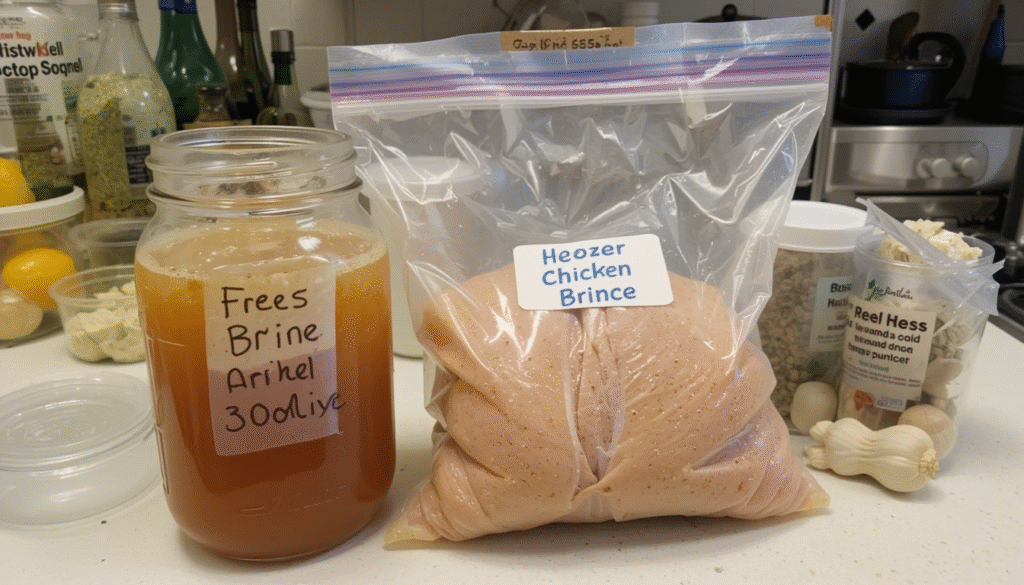
🧾( H2: Chicken Brine Recipe (Printable Card
This simple yet effective chicken brine recipe ensures your poultry turns out incredibly juicy and flavorful every time. Below is a printable, easy-to-follow card to save and use whenever you need perfectly seasoned chicken.
🛠️ H3: Equipment
You don’t need fancy kitchen tools — just a few basic items:
- Large stockpot or mixing bowl (non-reactive)
- Whisk or spoon
- Measuring cups and spoons
- Food-grade container or large resealable plastic bag
- Paper towels
- Tongs (optional)

🧂 H3: Ingredients (for 1 gallon of brine, enough for a 4–5 lb whole chicken)
- 1 gallon (16 cups) cold water
- ½ cup kosher salt
- ½ cup brown sugar (or white sugar)
- 1 tablespoon black peppercorns
- 4 cloves garlic, smashed
- 2–3 bay leaves
- 1 small onion, quartered
- 1 lemon, sliced (optional)
- Fresh herbs (like thyme, rosemary, or parsley — optional)
- Ice (as needed to cool brine quickly)
Optional Add-Ins for Flavor:
- Apple cider vinegar (1–2 tablespoons)
- Crushed red pepper flakes
- Orange slices or zest
- Juniper berries or cloves
🧑🍳 H3: Instructions
- Create the Brine Base: In a large stockpot, combine 4 cups of water with the salt and sugar. Heat over medium heat, stirring until both dissolve completely.
- Add Aromatics: Stir in garlic, bay leaves, peppercorns, onion, lemon, and herbs. Remove from heat.
- Cool the Brine: Add the remaining cold water and a few cups of ice to bring the temperature down quickly. Brine must be completely cold before adding chicken.
- Submerge the Chicken: Place chicken in a container or resealable bag and pour brine over. Ensure chicken is fully covered. Seal or cover and refrigerate.
- Brining Time:
- Whole chicken: 8–12 hours
- Chicken pieces: 1–2 hours
- Boneless cuts: 30–60 minutes
- Whole chicken: 8–12 hours
- Rinse & Dry: After brining, rinse chicken under cold water and pat dry with paper towels before cooking.
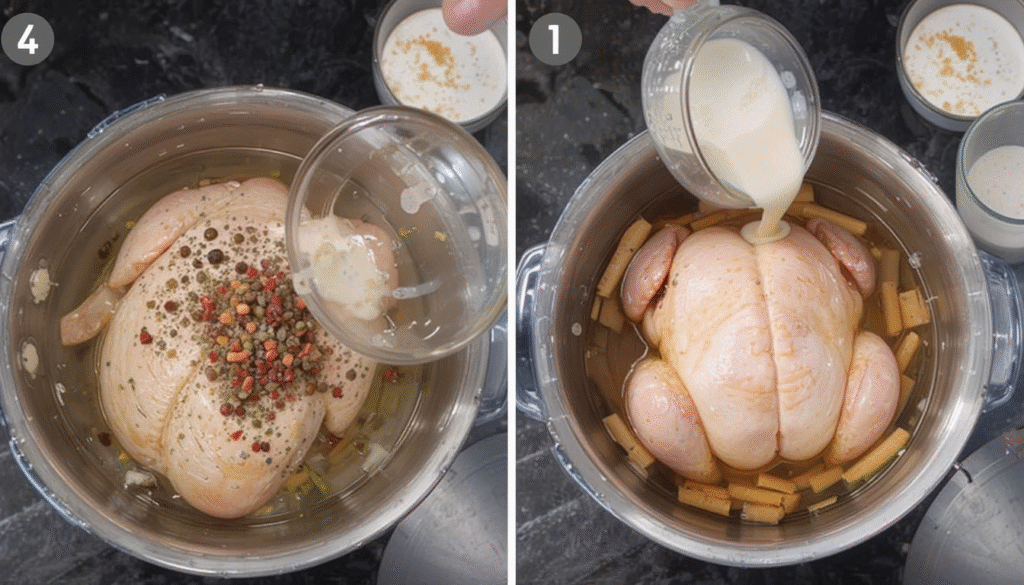
📝 H3: Notes
- If using table salt, reduce quantity to ⅓ cup (since it’s denser than kosher salt).
- For food safety, always brine in the refrigerator — never at room temperature.
- You can adjust aromatics and sweeteners to fit your desired flavor profile.
- Always dry chicken thoroughly before cooking for best browning.
🎥 H3: Video (if available)
Include an embedded how-to video demonstrating the brining process, from mixing to submerging to cooking.
🧮 H3: Nutrition Facts (Per Serving)
Approximate values per serving (based on 6 servings and no added fat or skin):
- Calories: 120
- Protein: 24g
- Fat: 3g
- Carbohydrates: 2g
- Sodium: 880mg (varies depending on rinsing)
- Cholesterol: 75mg
🔍 Note: These values are estimates and may vary based on specific ingredients and rinsing technique.
❓ H2: FAQs About Brining Chicken
Curious about the dos and don’ts of using a chicken brine recipe? These frequently asked questions will help you get the most flavorful and tender results every time.
🧊 Can You Brine Frozen Chicken?
Yes — but with a catch.
While it’s ideal to brine thawed chicken, you can brine frozen chicken if you allow it to defrost slowly in the brine. As the chicken thaws, it begins absorbing the seasoned water, making it a convenient two-in-one process.
Tip:
If starting with frozen chicken, extend the brining time slightly (e.g., up to 14–16 hours for a whole bird). Make sure the brine remains cold throughout the process to avoid any food safety issues.
⏳ Is It Possible to Over-Brine?
Absolutely.
Brining for too long can cause the meat to become too salty or mushy. The salt breaks down muscle proteins — a little of that is great for juiciness, but too much leads to a poor texture.
Recommended Brining Times:
- Whole chicken: 8–12 hours
- Bone-in pieces: 1–2 hours
- Boneless breasts or thighs: 30–60 minutes
Always follow brining times carefully and never exceed 24 hours.
📷: Visual timeline comparing ideal vs. over-brined chicken with text labels: “Juicy & Tender” vs. “Mushy & Salty.”

🧂 What Type of Salt is Best?
Kosher salt is the gold standard for brining. It dissolves easily and evenly distributes flavor. Its larger flakes make it easier to control saltiness compared to table salt.
Substitution Tips:
- Kosher Salt (preferred): ½ cup per gallon of water
- Table Salt: ⅓ cup per gallon of water (more dense and salty)
- Sea Salt: Varies by brand and grain size — use with caution
❗ Never use iodized salt for brining — it can add an unwanted metallic or bitter taste.
📷 : Close-up image of different salt types in labeled bowls: Kosher, Table, Sea Salt.
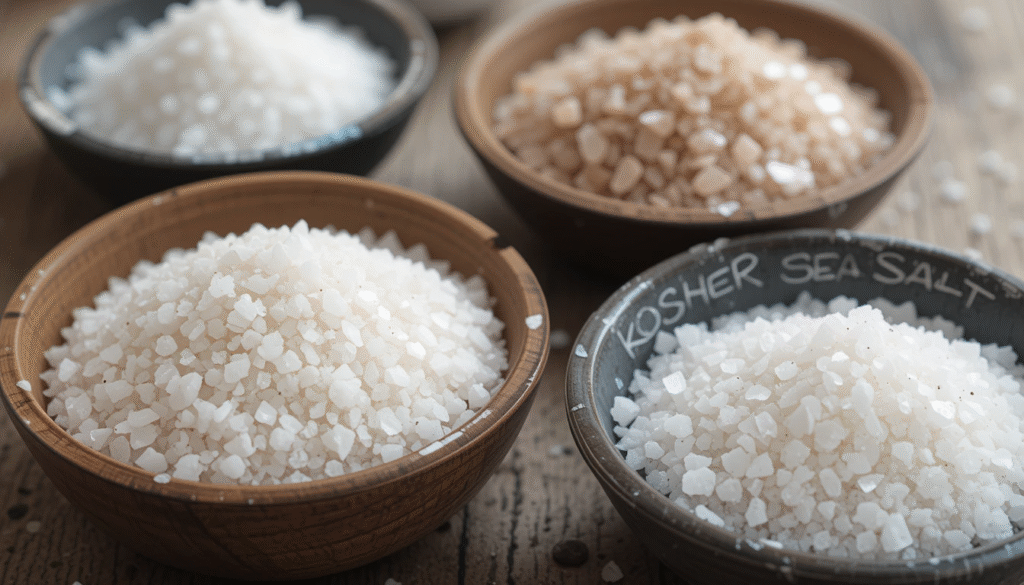
🍽️ H2: What to Serve With Brined Chicken
Brined chicken is juicy, flavorful, and versatile, making it perfect for pairing with a wide variety of side dishes. Whether you’re planning a casual weeknight dinner or an elegant gathering, here are some delicious ideas to complement your perfectly brined chicken.
🥗 Side Dish Suggestions
- Roasted Vegetables: Carrots, Brussels sprouts, sweet potatoes, and asparagus roasted with olive oil, garlic, and herbs make a colorful, nutrient-packed side.
- Creamy Mashed Potatoes: The rich, buttery texture balances the saltiness and tenderness of brined chicken perfectly.
- Herb Rice or Pilaf: Fluffy rice tossed with fresh herbs like parsley, thyme, and lemon zest adds a fresh note to the meal.
- Fresh Garden Salad: Crisp greens with cucumbers, cherry tomatoes, and a light vinaigrette provide a refreshing contrast.
- Cornbread or Dinner Rolls: Soft bread is perfect for soaking up any delicious juices or sauces.
- Grilled or Sautéed Mushrooms: Earthy mushrooms pair wonderfully with chicken’s subtle flavor.
- Coleslaw or Cabbage Slaw: A tangy, crunchy slaw adds a bright, refreshing crunch.
🎉 Serving Ideas for Any Occasion
- Weeknight Family Dinner: Pair brined chicken with simple roasted veggies and mashed potatoes for a comforting and balanced meal.
- Holiday Feast: Serve alongside garlic herb stuffing, cranberry sauce, and green bean casserole for a festive spread.
- Summer BBQ: Brined grilled chicken served with corn on the cob, watermelon salad, and chilled pasta salad.
- Dinner Party: Present brined chicken with a gourmet mushroom risotto, asparagus spears, and a light arugula salad.
- Meal Prep: Slice leftover brined chicken and add it to grain bowls with roasted veggies and a tangy dressing for easy lunches.
📷 : Plated brined chicken served with a colorful assortment of roasted vegetables, mashed potatoes, and a fresh garden salad.
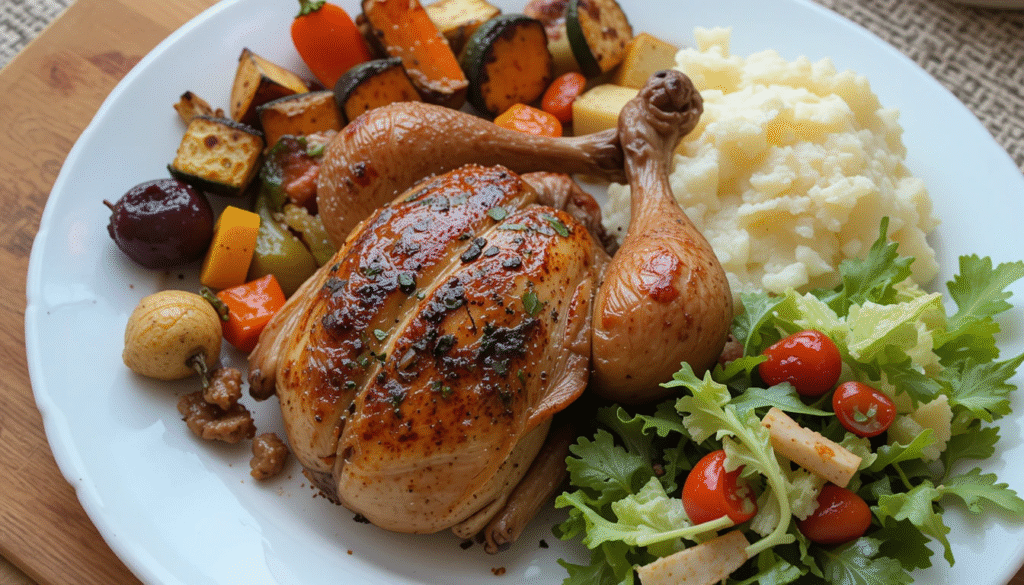
🌶️ 🌟 H2: Variations of Chicken Brine
Experimenting with different chicken brine recipes can add exciting flavors and elevate your poultry dishes. Here are some popular and tasty variations to customize your brine and keep your meals fresh and flavorful.
🌶️ Spicy Brine
For those who like a little heat, a spicy brine adds a bold kick that penetrates the chicken for a flavorful punch.
How to Make It:
Add crushed red pepper flakes, cayenne pepper, or fresh sliced jalapeños to your basic brine mix. You can also include smoked paprika or hot sauce for extra depth.
Flavor Profile:
This brine enhances the chicken with a warm, spicy undertone that pairs perfectly with grilled or roasted dishes.
🍋 Citrus or Herb-Infused Brine
Brighten your chicken with refreshing citrus and aromatic herbs for a clean, vibrant flavor.
How to Make It:
Add sliced lemons, limes, or oranges to your brine, along with fresh herbs such as rosemary, thyme, sage, or parsley. You can also toss in some garlic cloves and peppercorns for more complexity.
Flavor Profile:
The citrus adds zesty brightness, while herbs contribute an earthy, fragrant aroma that enhances the natural chicken flavor.
🥛 Buttermilk Brine Option
A classic Southern twist, the buttermilk brine not only tenderizes but also imparts a subtle tang and creaminess to the chicken.
How to Make It:
Replace part or all of the water in your brine with buttermilk. Add salt, sugar, and spices like paprika, garlic powder, and black pepper. The acidity in buttermilk breaks down proteins for ultra-tender meat.
Flavor Profile:
The result is rich, moist chicken with a slight tang that’s ideal for frying or baking.
📷 Image 1: Jar of spicy chicken brine with visible chili flakes and jalapeño slices floating inside.
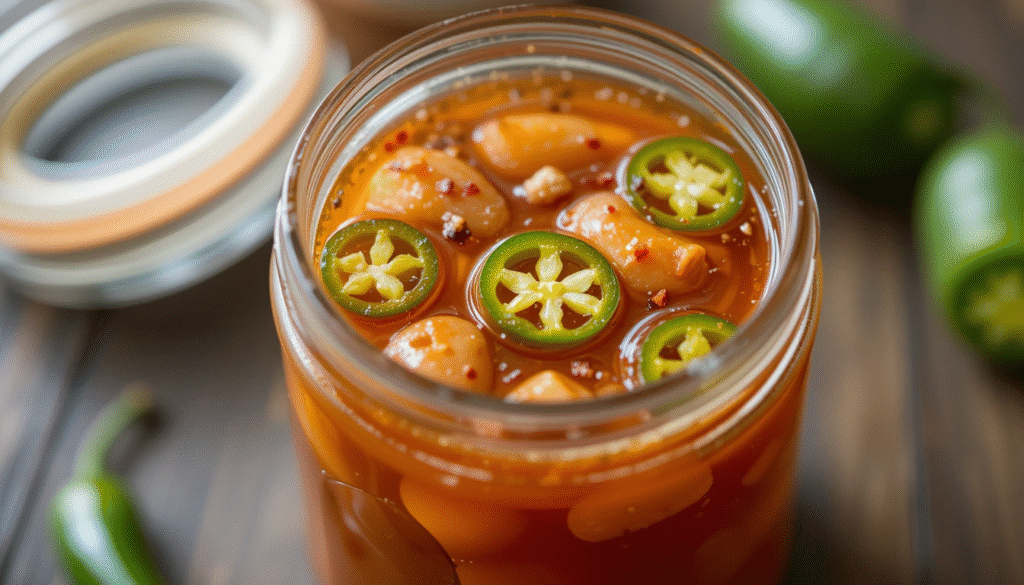
📷 Image 2: Lemon and herb brine in a clear bowl with fresh rosemary and thyme sprigs.
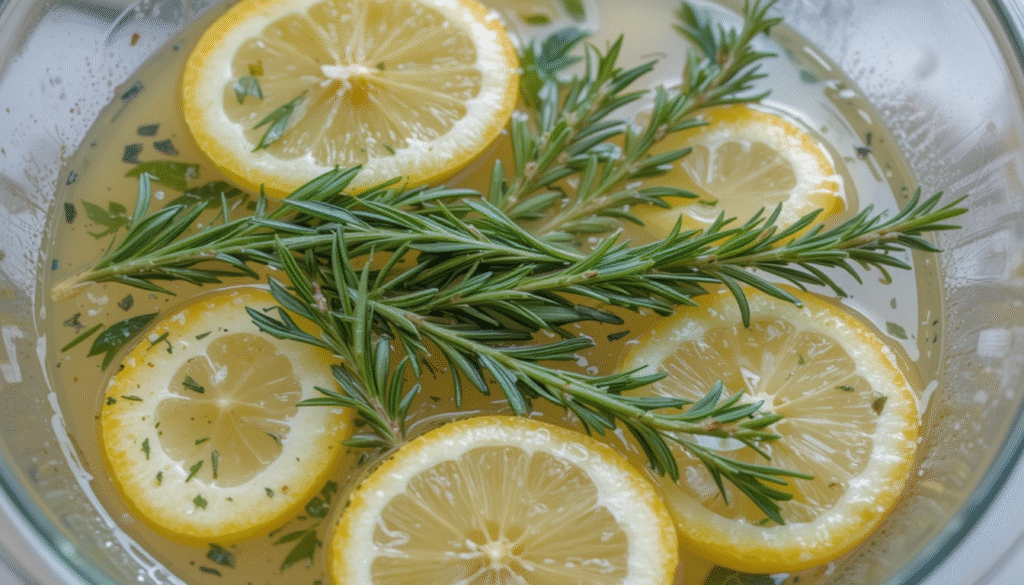
📷 Image 3: Buttermilk brine in a large bowl with chicken pieces soaking, sprinkled with paprika and black pepper.
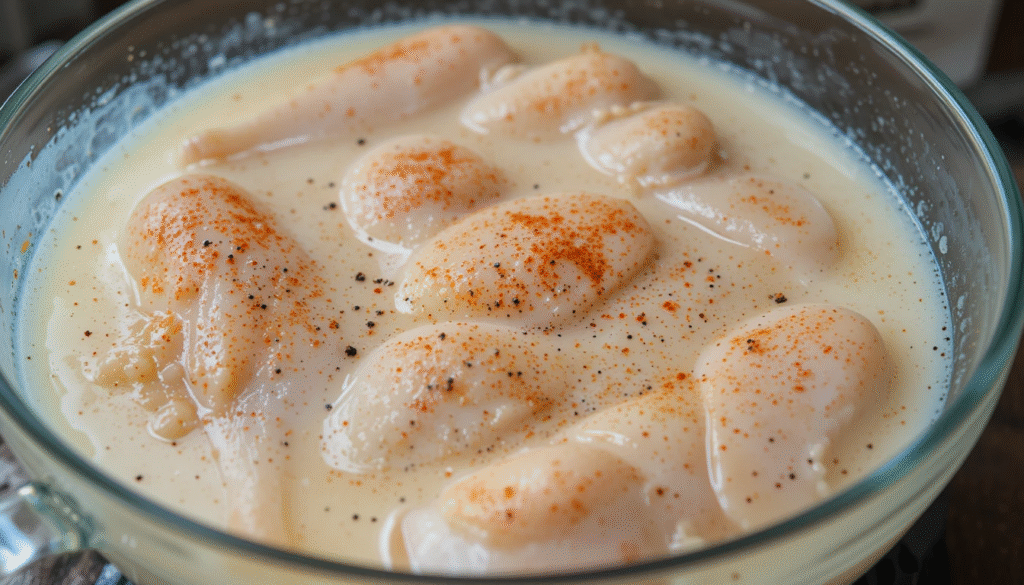
👩🍳 H2: Reader Tips and Community Favorites
Our community of home cooks and chicken lovers has shared some fantastic tips and favorite twists on the classic chicken brine recipe. Here’s what readers recommend for achieving the best results and adding their own creative flair.
💬 Comments from Readers
- “I always brine my chicken overnight, and it turns out incredibly juicy every time. Adding a splash of apple cider vinegar really enhances the flavor!” – Sarah M.
- “Using kosher salt instead of table salt made a huge difference in taste and texture. Highly recommend!” – David L.
- “For a quick weeknight meal, I brine chicken breasts for just an hour, then grill them with a smoky spice rub. So good!” – Jessica R.
- “I love adding fresh herbs like rosemary and thyme to the brine; it adds such a wonderful aroma and depth.” – Michael T.
🌟 Popular Variations
- Garlic & Herb: Many readers swear by adding plenty of smashed garlic cloves and fresh herbs to the brine for extra fragrance.
- Sweet & Spicy: Some community members mix in honey or brown sugar along with crushed red pepper flakes to balance heat with sweetness.
- Citrus Twist: Fresh lemon or orange slices are a favorite addition to brighten the brine and add subtle citrus notes.
- Buttermilk Brine: A popular Southern-inspired option, great for tenderizing and adding a slight tang, especially for fried chicken.
Sharing your own tips or favorite brine variations? Drop a comment below and join the conversation!
📷 Image : A cozy kitchen scene with a jar of herb-infused chicken brine surrounded by fresh herbs, garlic bulbs, and citrus fruits, with handwritten recipe notes nearby.
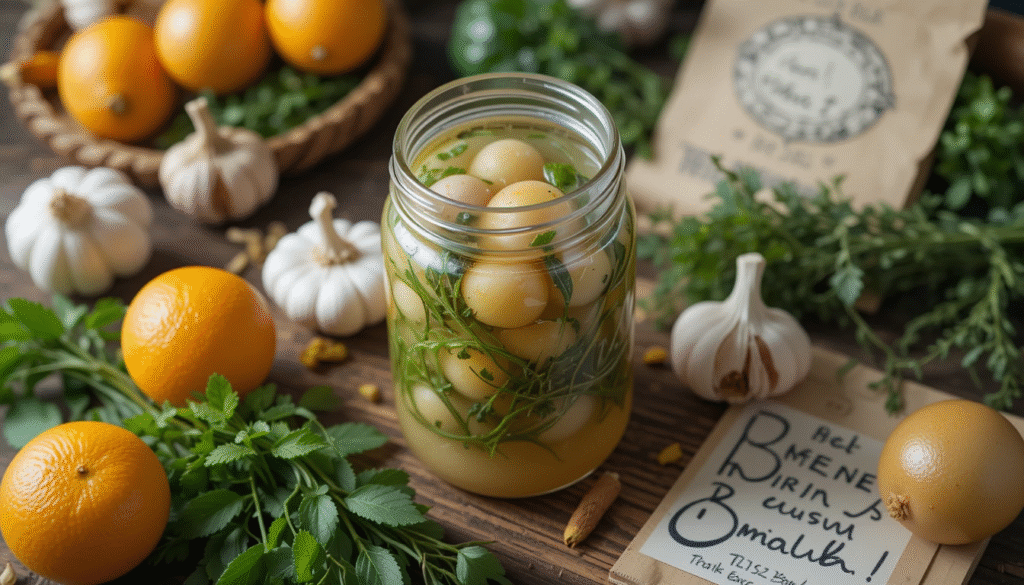
🍴 H2: More Chicken & Poultry Recipes You’ll Love
- Looking to expand your chicken repertoire? These delicious and easy-to-make recipes are perfect companions to your chicken brine recipe. Each offers unique flavors and cooking methods that will keep your meals exciting and satisfying.
- 🍲 Creamy Chicken Florentine
- This classic dish features tender chicken breasts cooked in a luscious spinach and cream sauce, perfect for a comforting weeknight dinner. The rich flavors pair beautifully with the juicy texture from a good brine.
- 💍 Marry Me Chicken
- A fan favorite, Marry Me Chicken is a savory, creamy dish made with sun-dried tomatoes, garlic, and parmesan cheese. Its indulgent sauce is great for impressing guests or enjoying a cozy meal at home.
- 🍗 Air Fryer Whole Chicken
- Get crispy, golden skin and juicy meat with this easy air fryer whole chicken recipe. Brining the chicken beforehand ensures maximum flavor and tenderness, making this a quick yet impressive meal option.
- Try these recipes to complement your brined chicken and bring variety to your table!
- 📷 Image Prompt: A collage featuring creamy Chicken Florentine on a plate, a skillet of Marry Me Chicken with sauce, and a golden air fryer whole chicken resting on a cutting board.


